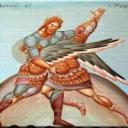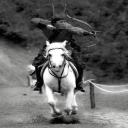Yahoo Answers is shutting down on May 4th, 2021 (Eastern Time) and beginning April 20th, 2021 (Eastern Time) the Yahoo Answers website will be in read-only mode. There will be no changes to other Yahoo properties or services, or your Yahoo account. You can find more information about the Yahoo Answers shutdown and how to download your data on this help page.
Trending News
How do traditional and modern martial art styles differ?
I was wondering what the definitions for "traditional" and "modern" martial art style are. I mean, something like taekwondo whose earliest international committee was formed in 1966 (so it has only been around for 46 years) is considered to a "traditional" style but a style like Brazilian Jiu Jitsu who's first ever organization was formed in 1976 (only ten years younger than taekwondo) is known to be a "modern" martial art style.
Why is that so?
How are the arts taught differently?
Ultimately, how are the two styles different? (I don't mean that brazilian jiu jitsu is a grappling art and taekwondo is a striking one. I mean how are modern and traditional styles are different.)
I have studied Taekwondo for quite a long time but whats the difference b/w modern and traditional art. Which one is more effective
12 Answers
- possumLv 77 years agoFavorite Answer
Many people have their own idea as to what it is. The definition depends largely on context and the speaker's or writer's own definition.
Almost always, modern is used to refer to MMA and BJJ.
Most of the time, traditional is used to refer to Karate, Aikido, Taekwondo and other styles that have been around for eons - despite that many of these styles are not very old - although no one ever seems to define "traditional" as old.
So for me, I prefer to categorize them by training methods: older, more traditional styles of teaching would include Taekwondo, Karate, Aikido.
And I would categorize modern to include MMA, BJJ, Krav Maga, and Taekwondo (yes - it's in both categories). They aren't old, and so, there aren't any "traditional" teaching methods - the styles are too new.
As to others, like wrestling, pankration, boxing, sumo, and others - they are predominantly fighting sport. Are they martial arts? I'm on the fence; some say yes, and others say no. But regardless, if the art/sport is taught they way it was when it started, then, it is traditional. Otherwise, it is modern.
Modern simply means "new", or "new era", or "recent". When "traditional" is used, the context is always in contrast, so, the speaker almost always means "old" - even though there is no definition of traditional that means "old". These same people - myself included - will label Taekwondo and Aikido as tradititional, even though they are neither old nor have a traditional way to teach them, because they aren't old. And, because I have experience in both, I can say that different instructors will teach them differently: some will say "do as I say and don't ask questions" - that's traditional. Others will say "do as I say, and let's explore why this is the best way to do it" - that's modern. So even within a style, you have old ways of teaching it, and you have new ways.
It won't do to come up with a commonly-agreed upon definition. Many will disagree with whatever definition we come up with.
I'm not sure I would divide the categories according to self-defense vs sport. Krav Maga, for instance, or Aikido, Taekwondo - they're all modern - some are taught in both modern and ancient fashion. Where would you label these styles? And pankration is taught today largely as it was back then, although perhaps not as violently as it was - maybe this means it is modern? And boxing: it used to have throws and grappling - now it doesn't. I suppose if you box and are taught to use grappling, then you're in a tradititional boxing class. And wrestling used to have strikes. If you're taught to use strikes, you're in a traditional wrestling class.
- Anonymous5 years ago
I like pugspaw explanation. However, this would be hard to explain in my opinion. I base this on the premise that you have to clearly define modern martial arts. What many call a modern martial art are not considered to by many as a martial art. Examples: Kickboxing, muay thai, bjj krav maga are some that many would call a modern martial art. On the other hand many traditionalist would not dare call most or any of those listed as a martial art. I know some would argue why I listed muay thai as not being traditional. But those that have been taught muay boran would often argue that muay thai is anything but traditional. In a tradition art like shorin ryu, goju ryu, tkd you will find a rich tradition of concept, philosophy, and techniques that were handed down for generations. The techniques were taught from kata. The kata were passes down from generation to generation. The kata existed before the style were considered a style. The kata is not be be altered. Changing the kata would be in fact changing the art. Like pugspaw said these arts are complete systems within themselves if they are taught by someone with the knowledge that is willing to share the knowledge. Those of the modern era believe incorrectly that something is missing from the traditional art or that it is incomplete and some has to added to it to make it effective or useful. If there is any weakness it only lies in one of 2 places in my opinion. It lies in the skill of the artist themselves or in the instructor inability to teach the art as it was meant to be taught. I also like the quote that pugpaw used but I would add something to it. Don't fear the man that has don 10,000 technique, but fear the man that has done one technique 10,000 time. I would just add fear the man that has done 1 technique 10,000 times correctly.
- GeorgieLv 57 years ago
It is not a correct term....
MMA, Boxing and Wrestling that are consider modern by some, were all part of the Ancient Greek world. MMA back then had fewer rules and it was called Pankration. Boxing and Wrestling were called Boxing and Wrestling from back then.
Many of the arts that people are calling traditional have being created in the 20th century...
So accurately speaking, is not a correct term.
A better term would be Oriental martial arts rather than Traditional martial arts.
- SevLv 67 years ago
There's also traditional and modern forms of the same style.
TKD has both traditional and modern aspects. The modernized is the sport version. Traditional are the ones geared towards warfare.
EDIT: I'm more for the old style because the training was usually geared towards Self-defense and warfare. It's the individual that utilizes it but old style TKD gave me some competency in grappling and other methods of CQC than sport style.
There aren't enough characters to go into detail though so I'll just say the primary difference is modern era is sport oriented while traditional is not...usually
- How do you think about the answers? You can sign in to vote the answer.
- callsignfuzzyLv 77 years ago
BJJ has been around since the 1920's. It is, in some ways, older than Taekwondo.
At any rate, the age of something seems to have very little bearing on whether or not it's considered "traditional". Most "traditional" martial arts are products of the 20th Century. Queensberry-rules boxing is almost a century older than Wado-Ryu karate, and can arguably trace its roots back farther, but I'm not sure anyone would consider boxing "traditional", especially over Wado-Ryu.
In my experience, the folks who tend to self-identify as "traditional" martial artists tend to hold tradition above innovation. They seek to preserve a martial art as it was originally practiced, or at least how they THINK it was originally practiced. This includes adopting certain cultural trappings (vocabulary, etiquette, manner of dress) from the time and place the system originated.
Most who self-identify as "modern" martial artists are interested in modern tools and other resources, such as scientific studies. They are generally more willing to embrace change, though this can mean a shifting curriculum.
I don't particularly think either one is "more effective" in that either approach can provide the user with what they want. With that said, though the historian in me finds value in the "traditional" approach- we in the West have lost many fighting traditions because no one thought to preserve them- I prefer the more modern approach. Martial arts is the science of fighting, and one must be willing to embrace new data. "Traditional" martial arts were still just created by an individual or group at a certain period in time, with only the resources they had at their disposal. Much like every other science, we have learned more about the factors that go into creating a martial art (kinesiology, learning methods, patterns of crime, psychology, etc) than we did fifty or one hundred years ago. My goal is the practical application of fighting skills, and I think modern training methods, on the whole, do more to promote those skills than many "traditional" methods.
- jwbulldogsLv 77 years ago
First I'd like to say that TKD is not a striking style. It includes grappling in it as well if you have a good instructor and you are learn the art and not just a sports version of the art.
Traditional - is something handed down from one generation to the next. It is taught as a means to preserve some part of history. In the case of martial arts it is created with self defense in mind (life preservation). Some were used in warfare.
Modern - There are no modern martial arts. You don't reinvent the wheel. What most people are calling modern martial arts are in reality sports. They were created with competing in mind. They have taken portions of techniques and some strategies and have removed the killing, and limb destruction from a martial arts in order to compete. It can be used in self defense, but it is not self defense as taught. A better term would be a combat sport.
Neither is better than the other. It depends on your goals. If you want to learn to compete choose something that the focal point of the instruction is competing. If you want to learn life preservation choose something that was created for that purpose.
None of them mean anything if you don't have a good instructor and you learn to be a good student.
Martial Arts like karate, tkd, aikido, etc have been around a very long time. Most for centuries. There have been different styles within these arts that were created from the style in modern times. If you look at karate there many styles of karate. I can't name them all. But most are familiar with shotokan, shorin ryu, and goju ryu. Most of them share some of the same kata that were handed down. The kata used in them were created long before the existence if that particular system. You can look at aikido the same way. The created of aikido created it in modern times. But it comes from a system that was created long before called daito ryu aikijujutsu. The name Daito-ryu can be traced back about 900 years. If you take TKD it is thought of as a martial art created in more recently. However TKD existed prior to the Japanese invading Korea. But afterwards the Koreans combine some elements from both what was already taught in Korea with that which they learned from the Japanese. It is my understanding that later the Koreans wanted to remove in influence TKD had from the Japanese and then changed their curriculum and system for training.
Source(s): Martial Arts since 1982 - Jim RLv 77 years ago
You need to define "modern".
In the context you have here, you simply seem to mean martial arts, or sports.
Sports are not martial arts, they are sports.
My art (Shotokan) is a "modern" style, coming from the early 20th century.
You have a couple misconceptions going on here.
There is also the instructor to consider. No art is worth it's salt without good instruction.
- 7 years ago
Modern and traditional are poor terms although people understand what they mean. Better terms would be Competetion based arts and non Competetion arts. Non comp. arts tend to not evolve much and rely on the same techniques used when it was formed. Competetion arts always get tested and practitioners are always looking to get the edge. I prefer Competetion arts as with these, you know there effective as they are tested on a daily basis.
- JackLv 47 years ago
The main difference is in the mentality. Traditional martial arts are as much about fighting as it is about spirituality. You don't go to class to just learn how to fight. It's suppose to be this whole life style.
Modern martial arts as you call it is strictly about fighting. You go to class and it's no nonsense fighting. Hard training, harder sparing and nothing else. Modern martial artist have removed all of the mysticism from traditional arts. There are no secret techniques, no wise old men on top of mountains, nothing like that. That's the main difference as I see it. Some may disagree.
- pugpaws2Lv 77 years ago
No two people will agree where the dividing line is between traditional styles and modern styles.
To me if they use modern equipment like heavy bags, speed bags, and trains with the mindset that everything they do is directly applicable to competition, is to me a modern style. Modern styles see techniques as just techniques to be learned and practiced and then move on to learning new techniques. Evey technique is exactly what it looks like it is used for.
Traditional styles are styles that see the movements as having applications much more advanced than what they appear to be. They generally, but usually have Kata/Forms which are intended not to be used as they appear, but are intended to hide the more affective real life applications within them. The forms are no just mindless imaginary fights against multiple attackers. Each move, stance, body shift, hand and foot position has multiple possible realistic applications against one attack by one person. A Kata/Form is meant to be seen as many possible different applications and many different possibilities of how you could be attacked. In other words it is not a fight but many possible fights lasting one a second or two and using only one or two of the applications from the Form.
Traditional styles seek not to learn to do a technique and then just see the technique as it appears, but see it as a puzzle containing many more effective ways it can be applied in self-defense.
Traditional training will use the old ways of training such as using the Makiwara rather than the heavy bag.
Note: The heavy bag tends to teach how to push hard and move the bag/attacker. "A Properly constructed makiwara, when used Properly", teaches how to transfer energy from strikes into the attacker so that it generates explosive energy within the attacker, not push him. A properly done traditional punch will drop the attacker where he stands, rather than to knock him back.
...
Source(s): Martial arts training over 46 years, since 1967 Teaching martial arts 40 years, since November, 1973








